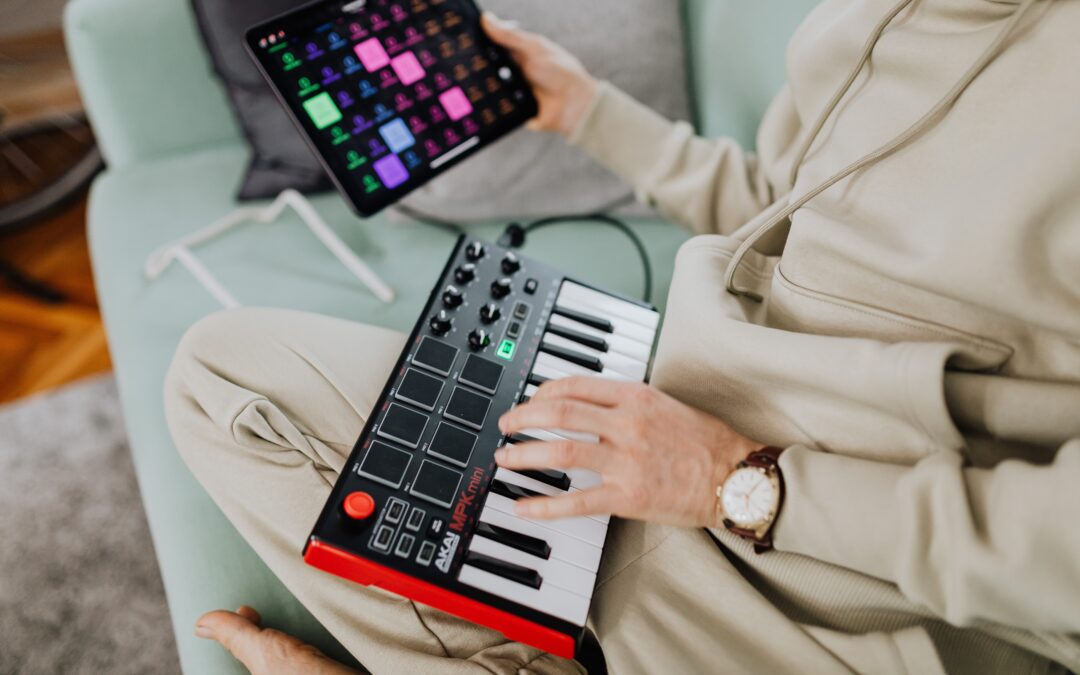Introduction
Music production is a complex art that often involves collaboration between artists and music producers. A music producer’s role goes beyond just technical skills; they can be a creative partner who shapes the sound and direction of a project.
In this blog post, we will delve into best practices for collaborating with music producers, drawing insights from credible sources and real-world examples from popular musicians.
Understanding the Role of a Music Producer
A music producer is like a guiding hand in the studio, helping artists realize their musical vision. They oversee the entire recording process, from pre-production to final mastering. Producers wear many hats, acting as sound engineers, arrangers, and often co-writers. According to renowned producer Rick Rubin, a producer’s role is to “help the artist get from A to Z” while preserving their artistic integrity.
Key Responsibilities and Contributions
Producers bring a range of skills to the table, including technical expertise, musical knowledge, and a keen ear for sound. They assist in song selection, arrangement, and instrumentation, making critical decisions that shape the final product. For example, Brian Eno’s work with U2 on “The Joshua Tree” is a testament to a producer’s role in crafting a signature sound.
Different Types of Music Producers
There are various types of music producers, each with their own specialization. Some are known for their technical prowess in recording and mixing, while others excel in creative direction and arrangement. For instance, Dr. Dre is celebrated for his production skills in hip-hop, while Max Martin is renowned for his songwriting and pop production expertise.
The Benefits of Collaborating with a Music Producer
One of the primary benefits of collaborating with a music producer is the injection of fresh ideas and creativity. Producers can challenge artists to think outside the box and explore new musical territories. Take the example of David Bowie’s collaboration with Brian Eno on the “Berlin Trilogy,” which resulted in groundbreaking experimental albums like “Low” and “Heroes.”
Improving Overall Sound Quality
Music producers are equipped with the technical knowledge to elevate sound quality. They use state-of-the-art equipment and techniques to ensure that the final mix is polished and professional. For instance, Quincy Jones’ work on Michael Jackson’s “Thriller” helped achieve its legendary sonic perfection.
Streamlining the Production Process
Collaborating with a music producer can streamline the production process. They bring experience and expertise to the table, helping artists avoid common pitfalls and delays. Timbaland’s partnership with Justin Timberlake on “FutureSex/LoveSounds” exemplifies how a producer can optimize workflow for a seamless recording process.
Finding the Right Music Producer
Finding the right producer starts with research. Artists should identify producers whose work aligns with their musical vision. This may involve listening to past projects, reading interviews, and seeking recommendations from fellow musicians.
Evaluating a Producer’s Portfolio and Experience
A producer’s portfolio is a treasure trove of information. Examining their previous work can reveal their stylistic range and creative tendencies. For instance, when Taylor Swift collaborated with Jack Antonoff on her album “1989,” she recognized his knack for crafting radio-friendly pop hits.
Establishing a Strong Rapport and Shared Vision
Once a potential producer is identified, it’s essential to establish a strong rapport and shared vision. Effective communication is key to a successful collaboration. Paul McCartney’s collaboration with George Martin of The Beatles is a prime example of a producer-artist partnership built on mutual trust and understanding.
Check out: Music Mastering Tips & Techniques
Effective Communication and Goal Setting
Effective communication is the cornerstone of any successful collaboration. Artists and producers should openly discuss their ideas, concerns, and expectations. Adele’s partnership with Paul Epworth on “21” thrived on open and honest communication, resulting in chart-topping hits.
Setting Project Goals and Expectations
Collaborators should set clear project goals and expectations from the outset. This includes defining the scope of work, timelines, and budget. Beyoncé’s collaboration with Pharrell Williams on her self-titled album exemplifies how clear goal-setting can lead to a successful project.
Establishing a Collaborative Workflow
Creating a collaborative workflow ensures that everyone is on the same page throughout the production process. Artists and producers should define roles, responsibilities, and decision-making processes. The chemistry between Daft Punk and Nile Rodgers on “Random Access Memories” is a testament to a well-defined collaborative workflow.

Preparing for the Collaborative Process
The pre-production phase involves careful planning and organization. This includes selecting songs, arranging compositions, and preparing demos. Adequate preparation sets the stage for a productive recording process. The Beatles’ “Sgt. Pepper’s Lonely Hearts Club Band,” produced by George Martin, benefited from meticulous pre-production.
Assembling the Necessary Resources
Artists and producers should ensure they have the necessary resources, including studio time, equipment, and session musicians. Adele’s collaboration with Ryan Tedder on “Rumour Has It” demonstrates the importance of having the right resources in place.
Legal Considerations and Agreements
Before diving into collaboration, it’s essential to address legal considerations and agreements, such as contracts and royalties. These agreements protect the rights and interests of all parties involved. The legal framework behind Dr. Dre’s partnership with Eminem showcases the importance of clear legal arrangements in the music industry.
Navigating Creative Differences
Collaboration isn’t always smooth sailing. Creative differences can arise, leading to conflicts. Artists and producers should be prepared to address these challenges constructively. The clash of artistic visions between Kanye West and Rick Rubin on “Yeezus” highlights the need to navigate creative differences with care.
Strategies for Resolving Creative Conflicts
When conflicts arise, it’s essential to have strategies in place for resolution. This may involve compromise, revisiting goals, or seeking outside perspectives. The collaboration between Johnny Cash and producer Rick Rubin on “American Recordings” demonstrated how creative conflicts could be resolved to create groundbreaking music.
Maintaining a Positive Working Relationship
Despite creative tensions, maintaining a positive working relationship is crucial for a successful collaboration. Respect, open communication, and a shared commitment to the project’s success can overcome challenges. The enduring partnership between Elton John and producer Gus Dudgeon resulted in timeless classics like “Rocket Man.”
Recording and Production Phase
The recording phase requires a well-equipped studio and meticulous preparation. Producers ensure that the studio environment is conducive to creativity and productivity. Radiohead’s collaboration with Nigel Godrich on “OK Computer” benefited from a carefully curated studio setup.
The Producer’s Role During Recording Sessions
During recording sessions, producers take on multiple roles, including guiding performances, providing feedback, and making real-time decisions. The close collaboration between Prince and his producer, Prince, on “Purple Rain” exemplifies how a producer can shape an artist’s sound in the studio.
Experimentation and Flexibility in Production
Collaborative production often involves experimentation and flexibility. Producers encourage artists to explore new sounds and techniques, pushing creative boundaries. The Chemical Brothers’ collaboration with Noel Gallagher on “Setting Sun” showcases how experimentation can lead to groundbreaking results.
Checkout: Music Producer vs Audio Engineer Career: Career Paths in Music
Post-Production and Mixing
Post-production and mixing are critical stages in music production. Producers work closely with mixing engineers to ensure that the final mix is polished and cohesive. This phase involves balancing and enhancing individual tracks to create a harmonious whole. The meticulous mixing process behind Pink Floyd’s “The Dark Side of the Moon,” guided by producer Alan Parsons, is a testament to the significance of this stage.
Collaborative Decision-Making in Mixing
Mixing is often a collaborative effort between artists, producers, and mixing engineers. Decisions regarding levels, effects, and sonic details require consensus. The collaborative mixing process on Fleetwood Mac’s “Rumours,” overseen by Ken Caillat, exemplifies the benefits of collective decision-making.
Fine-Tuning and Revisions
After an initial mix, artists and producers should be open to fine-tuning and revisions. This iterative process ensures that the final product meets the artistic vision. The perfectionism seen in the mixing and revising stages of Michael Jackson’s “Bad” with Quincy Jones exemplifies the commitment to sonic excellence.
Finalizing the Project
The mastering phase is crucial for ensuring consistent sound quality across all formats and platforms. It requires the skills of a mastering engineer to prepare the music for distribution. The meticulous mastering process behind Daft Punk’s “Random Access Memories,” by Bob Ludwig, showcases the importance of this final touch.
Feedback and Revisions
Feedback and revisions play a role even in the final stages of production. Producers and artists should remain receptive to feedback from trusted sources and make necessary adjustments. The iterative approach to finalization in the production of Kendrick Lamar’s “To Pimp a Butterfly,” with Dr. Dre as an executive producer, highlights this aspect.
Deliverables and Project Completion
With the project finalized, artists and producers must deliver the required assets to distributors and labels. This includes album artwork, metadata, and any promotional materials. The efficient delivery process behind Taylor Swift’s “Folklore,” produced by Aaron Dessner and Jack Antonoff, exemplifies how seamless project completion contributes to a successful release.
Case Studies: Successful Collaborations
To gain a deeper understanding of successful collaborations, let’s explore a few case studies:
The Beatles and George Martin: The legendary partnership between The Beatles and producer George Martin resulted in iconic albums like “Sgt. Pepper’s Lonely Hearts Club Band” and “Abbey Road.” Martin’s innovative production techniques and willingness to experiment elevated the band’s music to new heights.
Adele and Paul Epworth: Adele’s album “21” featured the hit single “Rolling in the Deep” produced by Paul Epworth. Their collaboration showcased how open communication, shared vision, and trust can lead to chart-topping success.
Daft Punk and Nile Rodgers: Daft Punk’s “Random Access Memories” marked a collaboration with legendary guitarist and producer Nile Rodgers. This project exemplifies the power of a well-defined collaborative workflow and the fusion of different musical backgrounds.
Johnny Cash and Rick Rubin: The collaboration between Johnny Cash and producer Rick Rubin on the “American Recordings” series revitalized Cash’s career. Rubin’s minimalist approach allowed Cash’s raw talent and emotions to shine through.
Pink Floyd and Alan Parsons: The mixing and sonic excellence of Pink Floyd’s “The Dark Side of the Moon” were guided by producer Alan Parsons. His attention to detail in the mixing process made the album a timeless classic.
From these case studies, we can draw several key takeaways:
- Collaboration with the right producer can elevate an artist’s work to new heights.
- Effective communication and shared vision are crucial for success.
- Flexibility and experimentation can lead to groundbreaking results.
- Iterative processes, including feedback and revisions, refine the final product.
- Trust and mutual respect are the cornerstones of successful collaborations.
Conclusion
Collaborating with music producers is an essential aspect of the music industry. It’s a partnership that can bring out the best in artists and lead to the creation of timeless music. Understanding the role of a music producer, setting clear goals, and navigating the collaborative process are crucial elements of a successful partnership.
As artists and producers continue to explore new horizons in music production, the potential for innovation and creativity remains boundless.
By following best practices and learning from successful collaborations, musicians can continue to create music that resonates with audiences worldwide. In the end, it’s the magic of collaboration that helps music transcend boundaries and touch the hearts of listeners everywhere.






